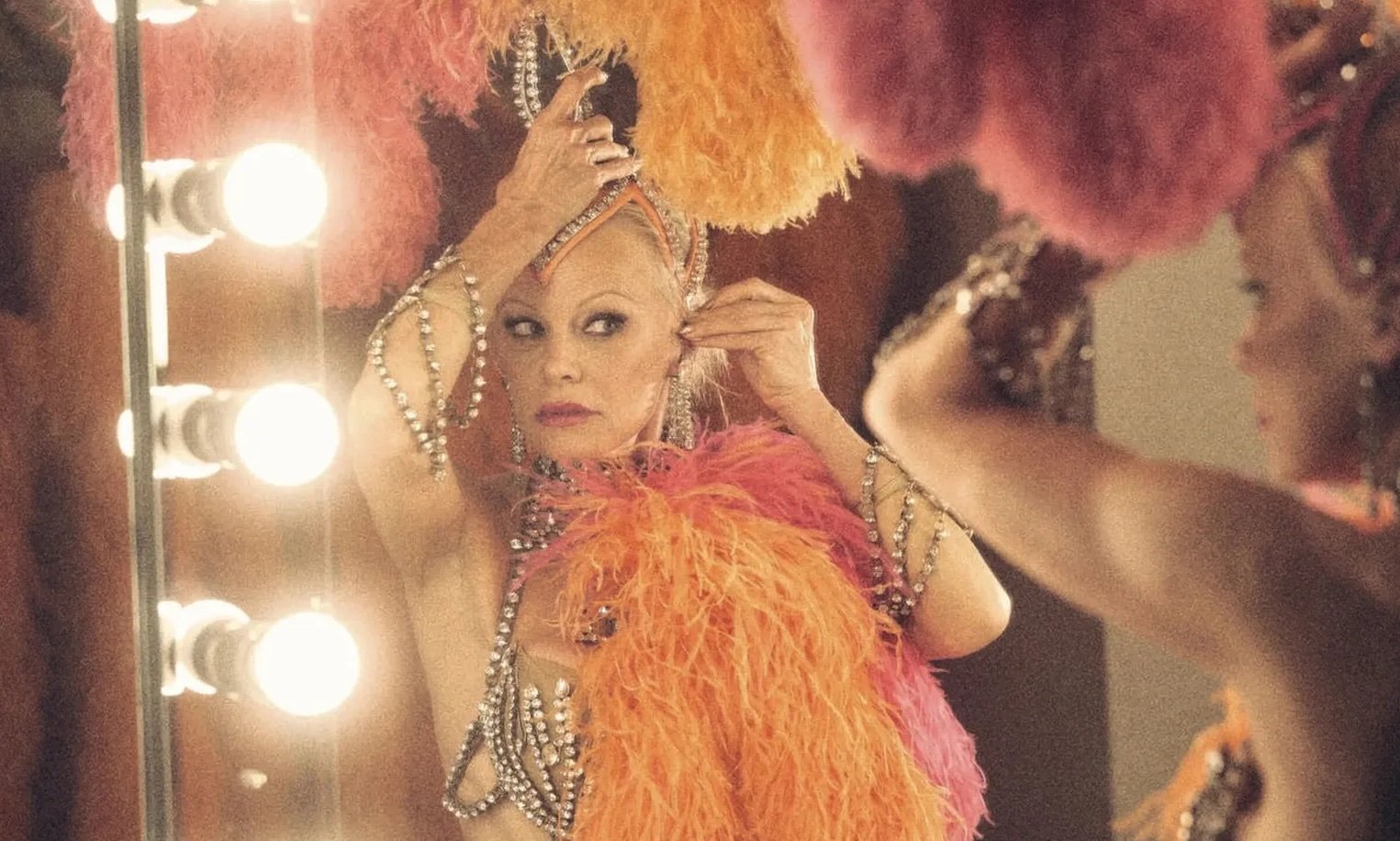Film review: Illusion and self-delusion as The Last Showgirl looks at a changing Las Vegas
Stunning performances in dreamily shot ode to women cast aside as Sin City leaves the rhinestone era

Pamela Anderson in The Last Showgirl.
The Last Showgirl opens at SilverCity Riverport and other Cineplex Theatres on January 17
RHINESTONES PLAY A starring role in Gia Coppola’s The Last Showgirl, piled with feathers and gloves in dressing-room pan shots and tinkling as dancers head out from backstage in their shimmery costumes. As gemstone wannabes they’re a perfect symbol for a film that looks at the cheaper reality of the glittery mirage of Las Vegas.
Filmed on grainy 16mm stock, The Last Showgirl has an aching, dreamy feel as it tells the story of the women who’ve helped construct that illusion of glamour—and the way they’re discarded as Sin City changes into an edgier, upscale destination.
B.C.’s Pamela Anderson makes a career-defining performance as the baby-voiced Shelly, a slightly ditzy, 50-something showgirl who’s spent 30 years playing a lead role in Le Razzle Dazzle casino spectacle that is set to be cancelled. A “dirty circus” is scheduled to take its place. She takes pride in the work she’s been doing since the ’80s, likening herself to the can-can girls of old Paris. “Breasts and rhinestones and joy!” she calls it, without an ounce of irony. It’s clear from her dated house with the empty communal pool that she needs the paycheque. Watch her try to practise her smile in the mirror before showtime right after a crying jag.
Shelly is restless, flitty, and deeply flawed—a hot mess of contradictions. On one hand, she’s trying hard to reconnect with the daughter Hannah (a riveting Billie Lourd) she neglected, attempting to bond over both of their dreams as “artists”. But the resentful Hannah, who’s studying at university as a photographer, doesn’t quite see things that way. Shelly also plays den mother to the lost younger dancers in her troupe, but is too absorbed in her own stress to help them when it really matters. And yet you have to admire her grit, even if it’s fuelled a bit by the self-delusion she needs to survive.
Some of the film’s best moments come in her scenes with Jamie Lee Curtis’s hardened ex-dancer Annette—complete with leathered bottle tan, bad auburn dye job, frosted lipstick and eyeshadow, and a cigarette sutured to her fingers (a kind of trashy sister to her matriarch on The Bear). She’s turned to “cocktailing” in a casino, carrying on full conversations with Shelly while guys shove tips into her bra.
At first it seems like gruff but softhearted stage manager Eddie (Dave Bautista) might offer the love and support Shelly needs—but that trajectory would be too simplistic for this film.
These are small, compelling character portraits heightened by Coppola’s artful direction. Long, heady scenes feature women looking over the Vegas strip, the desert sunset glinting off tacky glass buildings. Frequently, characters break into a dance all their own, on streets, in their living rooms—and in Curtis’s most stunning sequence, alone on a riser in a casino where the slot players don’t even notice.
In The Lost Showgirl, Coppola dances to her own offbeat groove, too, riffing on broken dreams, ephemeral youth, and the lies we tell ourselves—rooting out a kind of sad magic amid the rhinestones and fake smiles. ![]()
Janet Smith is cofounder and editorial director of Stir. She is an award-winning arts journalist who has spent more than two decades immersed in Vancouver’s dance, screen, design, theatre, music, opera, and gallery scenes. She sits on the Vancouver Film Critics’ Circle.
Related Articles
Lyana Patrick’s NFB documentary, recounting the Stellat’en and Saik’uz Nations’ ongoing fight for justice, returns for local screenings
Series includes all 13 of the French director’s films, including A Man Escaped, Pickpocket, Au hasard Balthazar, and more
Julie Rubio’s extensive new documentary, making its local debut at the VIFF Centre, reveals a trailblazing woman who was an outsider on several counts
HATCH, Clementine, One Day This Kid, and Beyond the Salish are among the 47 Canadian shorts screening this year
In the retrospective Secret Laws of the Cinematograph, the enigmatic French director’s hugely influential career comes into intense focus
Saints and Warriors, #skoden, and Sudan, Remember Us are among the titles that secured wins
Moonlight, Tehran: City of Love, and more explore themes of loneliness, belonging, and desire in program curated by Fay Nass
Ahead of a special live-scored screening, the renowned photographer and director reflects on “liminal spaces” and gore-filled supernatural encounters
Mr. Nobody Against Putin takes an urgent look at Russian indoctrination; Spare My Bones, Coyote! finds horrors at the U.S. border; Eight Postcards From Utopia runs weird commercials from free-market Romania; and more
In Have You Heard Judi Singh?, Vancouver director interweaves archival footage, re-created moments, and mesmerizing music in tribute to late Punjabi-Black artist
Montreal filmmaker Denis Côté started out making a portrait of a shy BDSM worker and ended up capturing a generation’s encounter with the endless recursions of social media
In NFB documentary, Lyana Patrick chronicles the environmental harm caused by the Kenney Dam
A panel discussion with workers and community advocates takes place after the VIFF Centre screening
Mareya Shot Keetha Goal: Make the Shot won a spot as best B.C. feature, plus much more as Surrey-based event hands out cash and development support
Moving from architectural marvel to frozen cabin, the film mixes bitter humour with a poetic fugue fuelled by familial trauma
Vancouver director Ben Immanuel drew from his acting students’ real experiences to craft a funny and poignant collaborative film that was years in the making
Program includes Vancouver premieres, returning classics, and a tribute to Tracey Friesen and free screenings on National Canadian Film Day
New paraDOXA initiative will highlight experimental films like To Use a Mountain
Director Mahesh Pailoor and producer Asit Vyas tell the impactful true story of a young man diagnosed with terminal cancer
In Aisha’s Story, a Palestinian matriarch uses food for generational healing, while Saints and Warriors follows a Haida basketball team
Event presented by SFU School for the Contemporary Arts features a screening of In the Garden of Forking Paths
First-time film actor Keira Jang takes a leading role in Vancouver director Ann Marie Fleming’s dark “satire” about a bucolic post-collapse future that comes with a catch
Stunning cinematography and a compelling story make documentary about freediver Jessea Lu a breathless watch
At The Cinematheque, Nanos Valaoritis’s memories of a long life in poetry are like a museum you never want to leave
Program includes Boy on a Dolphin, The Travelling Players, On the Waterfront, and more
Sepideh Yadegar’s film tells the story of an Iranian international student photographed at a Women, Life, Freedom protest in Vancouver
The series presents 14 titles by the master of nonfiction film, rarely seen in the cinema
Housewife of the Year unpacks a long-running Irish TV show, while There’s Still Tomorrow follows a working-class Italian woman in the 1940s
Director Sepideh Yadegar’s debut feature follows Iranian international student Sahar as she stands up for women’s rights in Vancouver
At Vancity Theatre, Christopher Auchter’s film takes us back to the 1985 protest that led to a historic win
































